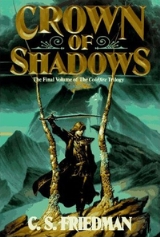
Crown of Shadows
Encyclopedia
Crown of Shadows is a Fantasy novel
by C.S. Friedman first published in 1995.
Fantasy literature
Fantasy literature is fantasy in written form. Historically speaking, literature has composed the majority of fantasy works. Since the 1950s however, a growing segment of the fantasy genre has taken the form of films, television programs, graphic novels, video games, music, painting, and other...
by C.S. Friedman first published in 1995.
Plot summary
In Crown of Shadows, Damien and Tarrant return to the west and Jaggonath, where they agree to work together long enough to kill Calesta. Damien discovers that the Patriarch of the Church, who is firmly against sorcery, is actually an Adept himself. Tarrant further strains relations with the Unnamed by revealing this fact to the Patriarch, and is dragged off to Hell for his pains. Damien convinces another Iezu, Karril, to lead him through Tarrant's personal Hell to the Unnamed, where he bargains for the Adept's life. The Unnamed agrees, on the condition that its contract with Tarrant will be broken in thirty-one days. If the Hunter has not found another way to sustain his immortal life by then, he will die. The Patriarch, already displeased at Damien's saving Tarrant for the first time in the Rakhlands, comes extremely close to casting him out of the priesthood. In the end, however, it is Damien who chooses to no longer be a priest, because his faith has been questioned too much by the Hunter, by himself, even by the Patriarch. Gerald Tarrant, on the other hand, has found a way to destroy an Iezu: feed it with the opposite emotion it normally thrives on. Karril, who lives off Pleasure, can also accept Pain, but Apathy will destroy him. Calesta, who embodies sadism, can only be destroyed by Altruism- the ultimate sacrifice, which Tarrant, amazingly, is willing to pay. The pair make their way to Mount Shaitan, a Volcano exuding an amazing amount of earth fae. It is enough to bind Tarrant and Calesta together as the adept opens himself to the burning power, killing them both. By this point, however, the Iezu's mother has been introduced. She created her children by taking emotions from human beings- in Karril's father's case, pleasure, in Calesta's, sadism. She takes away Gerald Tarrant's Hunter, the part of him that lives off pain and fear. In the process, she shocks him back to life- human life. The Neocount of Merentha has been given a second chance. However, all is not well back in the forest. In the second book, readers learned that Tarrant had not killed all of his children when he made the sacrifice to the Unnamed- he let his eldest son live. Now, after many generations, Andrys Tarrant has joined with the Patriarch in a campaign of vengeance. Gerald and Damien return to the Forest secretly, but are accosted by Andrys in the library, where they are trying to rescue the Hunter's Iezu notes from the destruction. Knowing he is about to die again, Gerald sends Damien from the room. Andrys emerges outside minutes later with the Hunter's severed head. Gerald Tarrant's original sacrifice, however, has changed the nature of the fae, so now any human willing to work it must also be willing to die. The Patriarch sacrifices himself, in a moving semi-final chapter, to ensure this effect will be permanent. As for Damien Vryce, however, this new world holds nothing for him. He stays in a small village in sight of the now burning forest, hunting the remaining fae-born creatures and trying not to think about what he's going to do with the rest of his life. All along, he wonders if the former Prophet is really gone. And with good reason- as is told in the last chapter.Damien Kilcannon Vryce
Main protagonist of the story. He is a priest from the Western Church, that is stubborn and in the previous books extremely zealous. In this book however he learns that sometimes sacrifices must be made to save all.Release details
- 1995, United States, DAW Books ISBN 0-88677-664-3, Pub date 1 October 1995, Hardcover *1996, United States, DAW Books ISBN 0-88677-717-8, Pub date 1 August 1996, Paperback reprint

